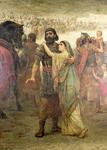The Trinity - through music
Today, on Trinity Sunday, I guess that there will be talk of three-leaf clover; water as ice, steam and liquid; and the other familiar yet defective ways of thinking about the Trinity.
With thanks, again, to Jeremy Begbie, I find this most helpful.
On a piano, play a middle C. The note comes from the piano, but fills the aural space. Now play the E above, and you have the second note; and then the G, and you have the third note. Play together and you have a chord of C major. Importantly, all three notes are in the same space at the same time. They are heard in and through each other. None are merged or hidden.
Begbie goes on to say that the Trinity is a three-note resonance of life, notes mutually indwelling without exclusion or merger, each occupying the same space yet recognisably and irreducibly distinct.
David Cunningham, takes this further in speaking of polyphony as, 'simultaneous, non-excluding difference: that is, more than one note is played at a time and none of the notes is so dominant that it renders the others mute.' And a variation on this with a great quote from Robert Jenson, 'God is a melody. And as there are three singers ... this melody is fugued. There is nothing as capacious as a fugue.'
This does it for me in a way that a clover leaf doesn't! I'm going to listen to Angela Hewitt play some Bach on the way to church.


Comments